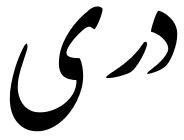Difference between revisions of "Language/Dari/Grammar/How-to-Use-Be"
m (Quick edit) |
m (Quick edit) |
||
| Line 106: | Line 106: | ||
<hr>➡ If you have any questions, please ask them in the comments section below.<br>➡ Feel free to edit this wiki page if you think it can be improved. 😎 | <hr>➡ If you have any questions, please ask them in the comments section below.<br>➡ Feel free to edit this wiki page if you think it can be improved. 😎 | ||
==Related Lessons== | |||
* [[Language/Dari/Grammar/Conditional-Mood|Conditional Mood]] | |||
* [[Language/Dari/Grammar/Pronouns|Pronouns]] | |||
* [[Language/Dari/Grammar/Gender|Gender]] | |||
* [[Language/Dari/Grammar/Give-your-Opinion|Give your Opinion]] | |||
* [[Language/Dari/Grammar/Adjectives|Adjectives]] | |||
* [[Language/Dari/Grammar/Negation|Negation]] | |||
* [[Language/Dari/Grammar/Plurals|Plurals]] | |||
* [[Language/Dari/Grammar/Questions|Questions]] | |||
* [[Language/Dari/Grammar/Nouns|Nouns]] | |||
{{Dari-Page-Bottom}} | {{Dari-Page-Bottom}} | ||
Revision as of 23:56, 28 February 2023
Hi Dari learners! 😊
In this lesson, we will learn how to use the verb "be" in Dari. We will look at the different forms of the verb and how to use them in sentences. We will also look at some examples of how to use the verb in context.
The verb "be" is used to describe a state or condition. In Dari, it is conjugated differently depending on the subject of the sentence. The verb "be" is conjugated as follows:
| Subject | Pronunciation | English Translation |
|---|---|---|
| انا (ana) | ɑnɑ | I |
| تو (to) | to | You (singular) |
| او (u) | u | He/She/It |
| ما (ma) | mɑ | We |
| توان (toan) | toɑn | You (plural) |
| اوان (uan) | uɑn | They |
The verb "be" is conjugated as follows:
| Present Tense | Pronunciation | English Translation |
|---|---|---|
| ام (am) | ɑm | I am |
| یی (yi) | ji | You are (singular) |
| است (ast) | ɑst | He/She/It is |
| ییم (yim) | jim | We are |
| یید (yid) | jid | You are (plural) |
| اند (and) | ɑnd | They are |
Here are some examples of how to use the verb "be" in context:
- Person 1: انا کجا هستم؟ (Ana kojā hastam?) (Where am I?)
- Person 2: تو در کلاس هستی. (To dar klās hasti.) (You are in the classroom.)
- Person 1: ما چه زمانی هستیم؟ (Ma che zamāni hastim?) (What time is it?)
- Person 2: اواست ساعت نه عصر. (Uast sā'at nah ʿaṣr.) (It is 5 o'clock in the afternoon.)
In addition to the present tense, the verb "be" can also be used in the past and future tenses. The past tense is conjugated as follows:
| Past Tense | Pronunciation | English Translation |
|---|---|---|
| بودم (budam) | budɑm | I was |
| بودی (budi) | budi | You were (singular) |
| بود (bud) | bud | He/She/It was |
| بودیم (budim) | budim | We were |
| بودید (budid) | budid | You were (plural) |
| بودند (budand) | budɑnd | They were |
And the future tense is conjugated as follows:
| Future Tense | Pronunciation | English Translation |
|---|---|---|
| خواهم بود (khāham bud) | xɑhɑm bud | I will be |
| خواهی بود (khāhi bud) | xɑhi bud | You will be (singular) |
| خواهد بود (khāhad bud) | xɑhɑd bud | He/She/It will be |
| خواهیم بود (khāhim bud) | xɑhim bud | We will be |
| خواهید بود (khāhid bud) | xɑhid bud | You will be (plural) |
| خواهند بود (khāhand bud) | xɑhɑnd bud | They will be |
Here are some examples of how to use the verb "be" in the past and future tenses:
- Person 1: او کجا بود؟ (U kojā bud?) (Where was he?)
- Person 2: او در خانه بود. (U dar khāne bud.) (He was at home.)
- Person 1: ما کجا خواهیم بود؟ (Ma kojā khāhim bud?) (Where will we be?)
- Person 2: ما در کنفرانس خواهیم بود. (Ma dar konferens khāhim bud.) (We will be at the conference.)
As you can see, the verb "be" is an important verb in Dari and is used to describe a state or condition. It is conjugated differently depending on the subject of the sentence and can be used in the present, past, and future tenses.
To improve your Dari Grammar, you can also use the Polyglot Club website. Find native speakers and ask them any questions!
➡ If you have any questions, please ask them in the comments section below.
➡ Feel free to edit this wiki page if you think it can be improved. 😎
Related Lessons
